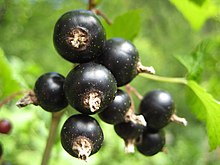 |
| Black Currant Cream Filled Ropes at Candy Babel- Supply is limited get here quick! |
The blackcurrant has been in domestic cultivation in Europe for up to
500 years. Its medicinal properties have been noted in various herbals.
During World War II, most fruits rich in vitamin C, such as oranges,
became almost impossible to obtain in the United Kingdom. Since
blackcurrant berries are a rich source of vitamin C and blackcurrant
plants are suitable for growing in the UK climate, blackcurrant
cultivation was encouraged by the British government. Soon, the yield of
the nation's crop increased significantly. From 1942 on, almost the
entire British blackcurrant crop was made into blackcurrant syrup (or
cordial) and distributed to the nation's children free, giving rise to
the lasting popularity of blackcurrant flavorings in Britain.
 |
| Black Currant |
During the 20th century in Europe much hybridisation work has been
carried out, in order to reduce the plant's susceptibility to disease
and frost, also to increase yields. This effort centred especially on
Russia, Sweden and Scotland, where the popular series of "Ben" cultivars
was developed by the Scottish Crop Research Institute.
Latterly, New Zealand has become an important centre for research and
development, as its temperate climate is beneficial to cultivation.
Why don't we see currants in the United States?
Blackcurrants were once popular in the United States as well, but
became rare in the 20th century after currant farming was banned in the
early 1900s, when blackcurrants, as a vector of white pine blister rust, were considered a threat to the U.S. logging industry.
The federal ban on growing currants was shifted to jurisdiction of
individual states in 1966, and was lifted in New York State in 2003
through the efforts of horticulturist Greg Quinn. As a result, currant growing is making a comeback in New York, Vermont, Connecticut and
Oregon.
However, several statewide bans still exist including Maine, New Hampshire and Massachusetts.
 |
| Red Currant Jellies! also available at CB while supply last! |
Since the American federal ban curtailed currant production
nationally for nearly a century, the fruit remains largely unknown in
the United States, and has yet to regain its previous popularity to
levels enjoyed in Europe or New Zealand. Owing to its unique flavor and
richness in polyphenols, dietary fibre and essential nutrients, awareness and popularity of blackcurrant is once again growing, with a number of consumer products entering the market.
 |
| Red Currant |
With maturity, the tart flavor of redcurrant fruit is slightly greater than its blackcurrant relative, but with the same approximate sweetness. The albino
variant of redcurrant, often referred to as white currant, has the same
tart flavor but with greater sweetness. Although frequently cultivated
for jams and cooked preparations, much like the white currant, it is
often served raw or as a simple accompaniment in salads, garnishes, or
drinks when in season.





No comments:
Post a Comment